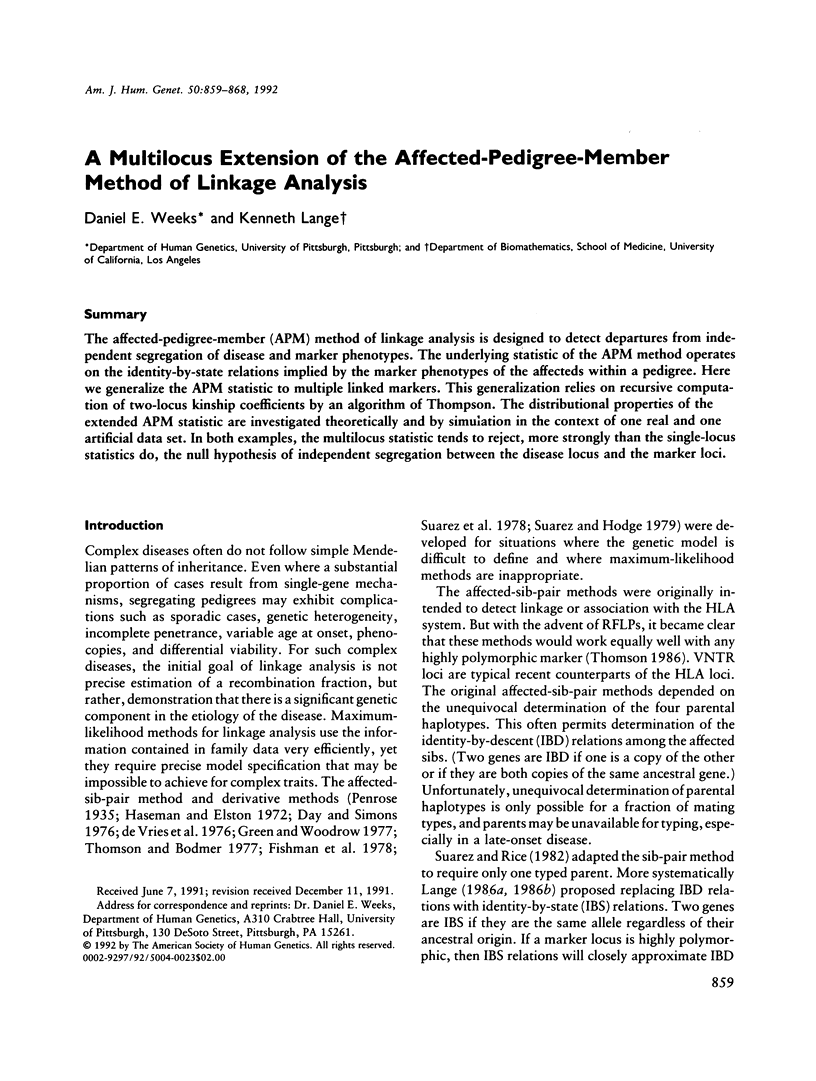A multilocus extension of the affected-pedigree-member method of linkage analysis (original) (raw)
. 1992 Apr;50(4):859–868.
Abstract
The affected-pedigree-member (APM) method of linkage analysis is designed to detect departures from independent segregation of disease and marker phenotypes. The underlying statistic of the APM method operates on the identity-by-state relations implied by the marker phenotypes of the affected within a pedigree. Here we generalize the APM statistic to multiple linked markers. This generalization relies on recursive computation of two-locus kinship coefficients by an algorithm of Thompson. The distributional properties of the extended APM statistic are investigated theoretically and by simulation in the context of one real and one artificial data set. In both examples, the multilocus statistic tends to reject, more strongly than the single-locus statistics do, the null hypothesis of independent segregation between the disease locus and the marker loci.

Selected References
These references are in PubMed. This may not be the complete list of references from this article.
- Day N. E., Simons M. J. Disease susceptibility genes--their identification by multiple case family studies. Tissue Antigens. 1976 Aug;8(2):109–119. [PubMed] [Google Scholar]
- Fishman P. M., Suarez B., Hodge S. E., Reich T. A robust method for the detection of linkage in familial disease. Am J Hum Genet. 1978 May;30(3):308–321. [PMC free article] [PubMed] [Google Scholar]
- Goate A., Chartier-Harlin M. C., Mullan M., Brown J., Crawford F., Fidani L., Giuffra L., Haynes A., Irving N., James L. Segregation of a missense mutation in the amyloid precursor protein gene with familial Alzheimer's disease. Nature. 1991 Feb 21;349(6311):704–706. doi: 10.1038/349704a0. [DOI] [PubMed] [Google Scholar]
- Green J. R., Woodrow J. C. Sibling Method for Detecting HLA-linked genes in disease. Tissue Antigens. 1977 Jan;9(1):31–35. doi: 10.1111/j.1399-0039.1977.tb01076.x. [DOI] [PubMed] [Google Scholar]
- Haile R. W., Goldstein A. M., Weeks D. E., Sparkes R. S., Paganini-Hill A. Genetic epidemiology of bilateral breast cancer: a linkage analysis using the affected-pedigree-member method. Genet Epidemiol. 1990;7(1):47–55. doi: 10.1002/gepi.1370070112. [DOI] [PubMed] [Google Scholar]
- Hall J. M., Lee M. K., Newman B., Morrow J. E., Anderson L. A., Huey B., King M. C. Linkage of early-onset familial breast cancer to chromosome 17q21. Science. 1990 Dec 21;250(4988):1684–1689. doi: 10.1126/science.2270482. [DOI] [PubMed] [Google Scholar]
- Haseman J. K., Elston R. C. The investigation of linkage between a quantitative trait and a marker locus. Behav Genet. 1972 Mar;2(1):3–19. doi: 10.1007/BF01066731. [DOI] [PubMed] [Google Scholar]
- Karigl G. A recursive algorithm for the calculation of identity coefficients. Ann Hum Genet. 1981 Jul;45(Pt 3):299–305. doi: 10.1111/j.1469-1809.1981.tb00341.x. [DOI] [PubMed] [Google Scholar]
- Labuda M., Morgan K., Glorieux F. H. Mapping autosomal recessive vitamin D dependency type I to chromosome 12q14 by linkage analysis. Am J Hum Genet. 1990 Jul;47(1):28–36. [PMC free article] [PubMed] [Google Scholar]
- Lange K. The affected sib-pair method using identity by state relations. Am J Hum Genet. 1986 Jul;39(1):148–150. [PMC free article] [PubMed] [Google Scholar]
- Lange K., Weeks D. E. Linkage methods for identifying genetic risk factors. World Rev Nutr Diet. 1990;63:236–249. doi: 10.1159/000418512. [DOI] [PubMed] [Google Scholar]
- Ott J. Computer-simulation methods in human linkage analysis. Proc Natl Acad Sci U S A. 1989 Jun;86(11):4175–4178. doi: 10.1073/pnas.86.11.4175. [DOI] [PMC free article] [PubMed] [Google Scholar]
- Pericak-Vance M. A., Bebout J. L., Gaskell P. C., Jr, Yamaoka L. H., Hung W. Y., Alberts M. J., Walker A. P., Bartlett R. J., Haynes C. A., Welsh K. A. Linkage studies in familial Alzheimer disease: evidence for chromosome 19 linkage. Am J Hum Genet. 1991 Jun;48(6):1034–1050. [PMC free article] [PubMed] [Google Scholar]
- St George-Hyslop P. H., Haines J. L., Farrer L. A., Polinsky R., Van Broeckhoven C., Goate A., McLachlan D. R., Orr H., Bruni A. C., Sorbi S. Genetic linkage studies suggest that Alzheimer's disease is not a single homogeneous disorder. Nature. 1990 Sep 13;347(6289):194–197. doi: 10.1038/347194a0. [DOI] [PubMed] [Google Scholar]
- St George-Hyslop P. H., Tanzi R. E., Polinsky R. J., Haines J. L., Nee L., Watkins P. C., Myers R. H., Feldman R. G., Pollen D., Drachman D. The genetic defect causing familial Alzheimer's disease maps on chromosome 21. Science. 1987 Feb 20;235(4791):885–890. doi: 10.1126/science.2880399. [DOI] [PubMed] [Google Scholar]
- Suarez B. K., Hodge S. E. A simple method to detect linkage for rare recessive diseases: an application to juvenile diabetes. Clin Genet. 1979 Feb;15(2):126–136. doi: 10.1111/j.1399-0004.1979.tb01751.x. [DOI] [PubMed] [Google Scholar]
- Suarez B. K., Rice J. P. The distribution of HLA haplotypes in families with one untyped parent. Tissue Antigens. 1982 Sep;20(3):193–197. doi: 10.1111/j.1399-0039.1982.tb00345.x. [DOI] [PubMed] [Google Scholar]
- Suarez B. K., Rice J., Reich T. The generalized sib pair IBD distribution: its use in the detection of linkage. Ann Hum Genet. 1978 Jul;42(1):87–94. doi: 10.1111/j.1469-1809.1978.tb00933.x. [DOI] [PubMed] [Google Scholar]
- Thompson E. A. Two-locus and three-locus gene identity by descent in pedigrees. IMA J Math Appl Med Biol. 1988;5(4):261–279. doi: 10.1093/imammb/5.4.261. [DOI] [PubMed] [Google Scholar]
- Thomson G. Determining the mode of inheritance of RFLP-associated diseases using the affected sib-pair method. Am J Hum Genet. 1986 Aug;39(2):207–221. [PMC free article] [PubMed] [Google Scholar]
- Weeks D. E., Lange K. The affected-pedigree-member method of linkage analysis. Am J Hum Genet. 1988 Feb;42(2):315–326. [PMC free article] [PubMed] [Google Scholar]
- Youngman S., Sarfarazi M., Quarrell O. W., Conneally P. M., Gibbons K., Harper P. S., Shaw D. J., Tanzi R. E., Wallace M. R., Gusella J. F. Studies of a DNA marker (G8) genetically linked to Huntington disease in British families. Hum Genet. 1986 Aug;73(4):333–339. doi: 10.1007/BF00279096. [DOI] [PubMed] [Google Scholar]
- de Vries R. R., Fat R. F., Nijenhuis L. E., van Rood J. J. HLA-linked genetic control of host response to Mycobacterium leprae. Lancet. 1976 Dec 18;2(7999):1328–1330. doi: 10.1016/s0140-6736(76)91975-9. [DOI] [PubMed] [Google Scholar]